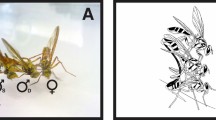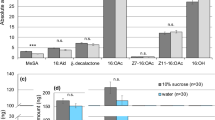Abstract
SPECIES of the Australian genus Harpobittacus (Bittacidae, Mecoptera) have a complex mating habit not recorded elsewhere in the Insecta (Bornemissza1). It involves the release of a sex pheromone by two intertergal vesicles on the abdomen of the males which lures females to its vicinity. Mating follows, during which the male presents to the female a nuptial meal consisting of a previously captured insect2. Of the six known species of Harpobittacus, the mating behaviour of four has been investigated and found to be essentially identical.
This is a preview of subscription content, access via your institution
Access options
Subscribe to this journal
Receive 51 print issues and online access
$199.00 per year
only $3.90 per issue
Buy this article
- Purchase on Springer Link
- Instant access to full article PDF
Prices may be subject to local taxes which are calculated during checkout
Similar content being viewed by others
References
Bornemissza, G. F., Nature, 203, 780 (1964).
Bornemissza, G. F. (in preparation).
Setty, L. R., Amer. Midl. Nat. Notre Dame Ind., 23, 257 (1940).
Riek, E. F., Austral. J. Zool., 2, 143 (1954).
Smith-White, S., Cold Spring Harb. Symp. Quant. Biol., 24, 273 (1959).
Tjeder, B., Mecoptera, in South African Animal Life, 3 (Almquist and Wiksells, Uppsala, 1956).
Author information
Authors and Affiliations
Rights and permissions
About this article
Cite this article
BORNEMISSZA, G. Specificity of Male Sex Attractants in some Australian Scorpion Flies. Nature 209, 732–733 (1966). https://doi.org/10.1038/209732a0
Issue Date:
DOI: https://doi.org/10.1038/209732a0
This article is cited by
-
A Male Sex Pheromone in a Scorpionfly
Journal of Chemical Ecology (2007)
Comments
By submitting a comment you agree to abide by our Terms and Community Guidelines. If you find something abusive or that does not comply with our terms or guidelines please flag it as inappropriate.



